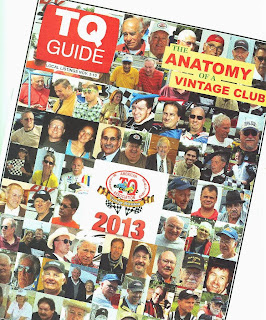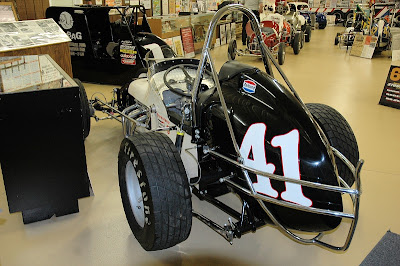Pine Brook Stadium, which opened in 1962 and closed in 1989, was not only the home track for the ATQMRA during that time, but it was also the only speedway operating in northern New Jersey. And while it was the last speedway to operate in northern New Jersey, it was certainly not the first. For the Independence Day holiday, here's the story of the track that infused Pine Brook builder Dick Marlow with a love of racing, a track which ran its last race exactly 75 years ago.
Written by Jim Wright, and published in The Record of Bergen County on July 3, 2013
Seventy-five years ago this summer, at a bygone place called the
Ho-Ho-Kus Speedway, a horrific crash ended an era in North Jersey.
In
the final race on Fourth of July 1938, drivers Henry Guerand and Vince
Brehm locked wheels, sending Brehm’s vehicle through a guardrail.
The
crash killed a 10-year-old Ridgewood boy and a 30-year-old man from
Hawthorne, whose leg was amputated with a pocket knife on the scene.
Seventeen others were injured.
The accident left such an
indelible mark that the speedway closed immediately and forever. After
World War II, the 23-acre property was sold to make way for houses.
Few
reminders of the once-famous speedway remain: Race Track Road (with
those giant green exit signs off Route 17), the enlarged old photos in
the Krauszer’s Food Store in downtown Ho-Ho-Kus, and a race-day poster
at the nearby Ho-Ho-Kus Inn.
Ho-Ho-Kus residents Kevin and Nancy
Pianfetti want to start changing all that. Their house sits on the site
of the speedway’s grandstand, and with the borough’s help, they want to
erect a historical marker about the speedway.
"Some amazing history happened there, and it needs to be acknowledged," said Kevin Pianfetti.
Unlike
modern asphalt racing tracks, built for 800-horsepower machines, the
Ho-Ho-Kus Speedway was a half-mile dirt oval originally designed for
one-horsepower thoroughbreds in the 1870s.
According to author
Gary Ludwig, who wrote a recent biography of champion race driver Tommy
Hinnershitz, safety was a major worry in the 1930s — even if precautions
were often minimal. "The circumstances were that drivers were going out
like crazy men on a half-mile dirt track," said Ludwig. "Someone was
bound to get hurt, and a certain amount of people were going to get
killed."
Ludwig says the auto races started out as driving
exhibitions on the horse tracks at county fairs, and when promoters
discovered there was money to be made, they turned the exhibitions into
pedal-to-the-metal races.
"Drivers had to accept the fact that
the equipment wasn’t the best, that you could get upside-down and lose
your life," he added. "They didn’t have roll bars, they didn’t have seat
belts. They wore those leather helmets that football players wore."
Drivers
did not want to be strapped into their open-wheel race cars because
they believed that if their car flipped, they were more likely to die if
they stayed in the car than if they were thrown clear of it. "What
really scared the guys in the ’30s was fire," said Ludwig. "Tommy
[Hinnershitz] in particular feared burning to death because when a fire
started, you couldn’t control it. No matter how fast the rescue guys got
to you, you were gone."
Safety measures for fans at many of the
tracks weren’t much better. The guardrails, after all, had been designed
for horses – not race cars.
Even though the speedway was in a
small town, it was immensely popular. Nearly 10,000 spectators were on
hand for the races on that fateful July 4 — not bad for a town with a
population of around 1,500.
The attraction of auto racing was the
same then and now: thrills and spills. Earlier that same day, for
example, a driver broke his right leg and suffered possible internal
injuries after his car overturned.
"That’s why we went — in hopes
of seeing accidents, but they were usually minor," says Allendale
resident Stiles Thomas, who as a young teen in the 1930s took the train
to Ho-Ho-Kus and walked a mile to the speedway.
"We could get
into the race track free if we were accompanied by an adult, or we could
climb trees on the peripheral part of the track," Thomas says. "All the
trees at the track were filled with boys watching the races. One time I
was sitting in a tree, and a tire from the raceway went flying over the
fence and out into the street."
"When the winds were right, you could hear the race
cars in Allendale [four miles away] and smell them, too, because they
added castor oil to the gasoline," Thomas recalled.
For young men within earshot,
the raceway offered a clarion call. Pine Brook Stadium builder Dick
Marlow grew up less than two miles from the track and with his older
brother, Alfred, would be among the teenagers climbing the trees around
the track.
In addition
to racer Bob Sall of Ridgewood, a top draw at the speedway was Ted Horn,
a California driver who relocated to Gasoline Alley in Paterson in the
1930s when the East Coast became the hotbed of auto racing.
 |
| Ted Horn at Ho-Ho-Kus |
Taurtoisemotorsports.com recounts an example of Horn’s charisma: "Before the race at Ho-Ho-Kus, he walked the track, studying every inch. Handsome, disciplined, well-dressed, and mostly, fast, Ted was an instant crowd favorite ... Horn won the first heat and the 30-lap feature, almost lapping the field. It was a new track record."
Horn came to embody that high-risk chapter in American open-wheel racing. The three-time national driving champion crashed in his very first race at age 16 in 1926, and died behind the wheel of a race car in Illinois 22 years later. Horn is buried in Paterson’s Cedar Lawn Cemetery — 10 miles south of the old Ho-Ho-Kus Speedway.
The racetrack also launched the career of one of the most-celebrated names in auto racing, Chris Economaki. As a young teenager in Ridgewood, he, too, heard the roar of the race cars at the speedway on Sunday afternoons.
"I’d go over there and look through the holes in the fence or sneak into the pits," Economaki later recalled. "I became intrigued. I got thrown out of the pits so often that, for my 13th birthday, my mother bought me a ticket, and I saw my first race from the stands."
Soon after, the young Economaki became a jack of all trades — selling a new auto-racing publication at the speedway, taking photos of the cars and drivers with a new little Kodak camera, and even writing for the weekly paper, called
National Speed Sport News. He eventually became publisher of the highly successful newspaper.
With the rise of television, Economaki became the nation’s leading commentator on auto racing. He appeared regularly on "ABC Wide World of Sports," and covered racing from the ATQMRA to the Indianapolis 500 and the Daytona 500. He even earned the unofficial title "Dean of American Motorsports."
Economaki died last September, at the age of 91. He is buried in Ridgewood’s Valleau Cemetery, a short walk from Race Track Road.
Economaki’s daughter, Tina Riedl of Paramus, said he always talked fondly of the raceway. "My father said one promoter would reserve a room at St. Joe’s or Paterson General — whatever the closest hospital was — and God forbid anybody got hurt, he’d have to pay for the room," said Riedl. "So he’d have the crew say to the driver, ‘You want to go to the hospital, or do you want to have a drink?’ If they settled for a drink, he’d take them to Patty Burke’s [located near the racetrack]."
Economaki himself steered clear of race-car driving. He once told a reporter he had raced a car only one time, in 1939: "I did worse than poorly. Finish? I felt lucky to be alive after the race."
Dick Marlow, too, did not compete, and never had an urge to try.
Jim Wright writes on a variety of local subjects. His latest ghost story, "Phantoms of the Ramapos," set in 1938, takes place at the Ho-Ho-Kus Speedway (among other locales). It is available as a free iBook download for iPads.















































